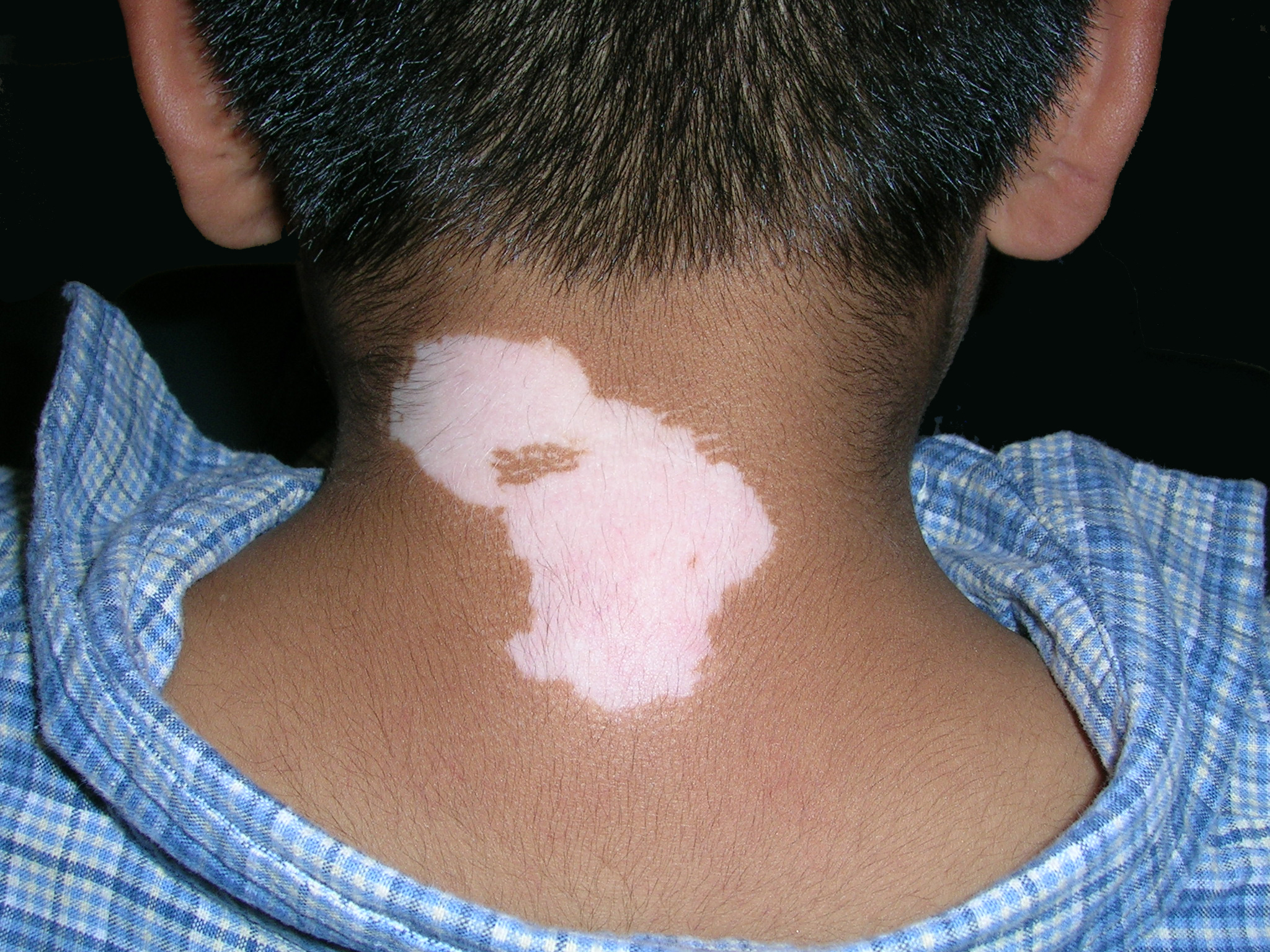User login

The FP made the diagnosis of vitiligo. The complete depigmentation and the distribution around the eyes is classic for vitiligo.
Vitiligo is an acquired, progressive loss of pigmentation of the epidermis. It can occur at any age, but typically develops between the ages of 10 and 30 years. Vitiligo occurs in all populations around the world, but is more prominent in those with darker skin. Vitiligo is an autoimmune disease with destruction of melanocytes. The typical distribution involves the face, hands, arms, and genitalia. Depigmentation around body openings such as the eyes, mouth, umbilicus, and anus is common.
Addressing the psychological distress that this disfiguring skin disorder causes should be a primary focus, since little can be done to modify the condition itself. When the area involved is limited and the patient requests treatment, some physicians will use topical high-potency steroids. Success rates are low, however.
Psoralen and ultraviolet A (PUVA) and narrowband UVB (NB-UVB) irradiation are somewhat effective treatments for vitiligo (approximately a 30%-60% response rate) when used alone and in combination with topical agents. However, the repigmentation is often spotty and incomplete. Sunscreen is recommended to prevent burns to the depigmented areas.
In this case, the patient’s mother wanted him to be treated. So the child was started on a moderate potency topical steroid to the involved area of the neck. When his mom saw no benefit in one month, she stopped the treatment.
Photos and text for Photo Rounds Friday courtesy of Richard P. Usatine, MD. This case was adapted from: Hughes K, Usatine R. Vitiligo. In: Usatine R, Smith M, Mayeaux EJ, et al, eds. The Color Atlas of Family Medicine. New York, NY: McGraw-Hill; 2009:849-852.
To learn more about The Color Atlas of Family Medicine, see:
• http://www.amazon.com/Color-Atlas-Family-Medicine/dp/0071474641
You can now get The Color Atlas of Family Medicine as an app for mobile devices including the iPhone and iPad by clicking this link:

The FP made the diagnosis of vitiligo. The complete depigmentation and the distribution around the eyes is classic for vitiligo.
Vitiligo is an acquired, progressive loss of pigmentation of the epidermis. It can occur at any age, but typically develops between the ages of 10 and 30 years. Vitiligo occurs in all populations around the world, but is more prominent in those with darker skin. Vitiligo is an autoimmune disease with destruction of melanocytes. The typical distribution involves the face, hands, arms, and genitalia. Depigmentation around body openings such as the eyes, mouth, umbilicus, and anus is common.
Addressing the psychological distress that this disfiguring skin disorder causes should be a primary focus, since little can be done to modify the condition itself. When the area involved is limited and the patient requests treatment, some physicians will use topical high-potency steroids. Success rates are low, however.
Psoralen and ultraviolet A (PUVA) and narrowband UVB (NB-UVB) irradiation are somewhat effective treatments for vitiligo (approximately a 30%-60% response rate) when used alone and in combination with topical agents. However, the repigmentation is often spotty and incomplete. Sunscreen is recommended to prevent burns to the depigmented areas.
In this case, the patient’s mother wanted him to be treated. So the child was started on a moderate potency topical steroid to the involved area of the neck. When his mom saw no benefit in one month, she stopped the treatment.
Photos and text for Photo Rounds Friday courtesy of Richard P. Usatine, MD. This case was adapted from: Hughes K, Usatine R. Vitiligo. In: Usatine R, Smith M, Mayeaux EJ, et al, eds. The Color Atlas of Family Medicine. New York, NY: McGraw-Hill; 2009:849-852.
To learn more about The Color Atlas of Family Medicine, see:
• http://www.amazon.com/Color-Atlas-Family-Medicine/dp/0071474641
You can now get The Color Atlas of Family Medicine as an app for mobile devices including the iPhone and iPad by clicking this link:

The FP made the diagnosis of vitiligo. The complete depigmentation and the distribution around the eyes is classic for vitiligo.
Vitiligo is an acquired, progressive loss of pigmentation of the epidermis. It can occur at any age, but typically develops between the ages of 10 and 30 years. Vitiligo occurs in all populations around the world, but is more prominent in those with darker skin. Vitiligo is an autoimmune disease with destruction of melanocytes. The typical distribution involves the face, hands, arms, and genitalia. Depigmentation around body openings such as the eyes, mouth, umbilicus, and anus is common.
Addressing the psychological distress that this disfiguring skin disorder causes should be a primary focus, since little can be done to modify the condition itself. When the area involved is limited and the patient requests treatment, some physicians will use topical high-potency steroids. Success rates are low, however.
Psoralen and ultraviolet A (PUVA) and narrowband UVB (NB-UVB) irradiation are somewhat effective treatments for vitiligo (approximately a 30%-60% response rate) when used alone and in combination with topical agents. However, the repigmentation is often spotty and incomplete. Sunscreen is recommended to prevent burns to the depigmented areas.
In this case, the patient’s mother wanted him to be treated. So the child was started on a moderate potency topical steroid to the involved area of the neck. When his mom saw no benefit in one month, she stopped the treatment.
Photos and text for Photo Rounds Friday courtesy of Richard P. Usatine, MD. This case was adapted from: Hughes K, Usatine R. Vitiligo. In: Usatine R, Smith M, Mayeaux EJ, et al, eds. The Color Atlas of Family Medicine. New York, NY: McGraw-Hill; 2009:849-852.
To learn more about The Color Atlas of Family Medicine, see:
• http://www.amazon.com/Color-Atlas-Family-Medicine/dp/0071474641
You can now get The Color Atlas of Family Medicine as an app for mobile devices including the iPhone and iPad by clicking this link: